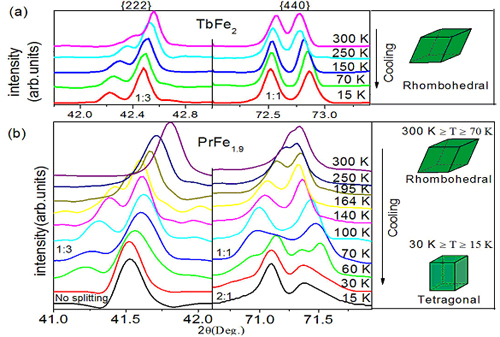New progress in both experiment and theory was achieved on the magnetostriction of the PrTe1.9 and TbFe2 alloys by using the X-Ray Diffraction (XRD) of the Steady High Magnetic Field Facilities(SHMFF).
Scientists found that PrFe1.9 exhibit colossal magnetostriction of 6700 ppmm at 70 K, which is far bigger than the 5600 ppm predicted by the conventional theory. The theoretical calculation indicates PrFe1.9 and TbFe2 would exhibit magnetostriction of 8000 ppm and 4200 ppm respectively at absolute zero Kelvin. With the decrease of temperature, the magnetization direction changes from [111] to [110], which give a good explanation on the temperature dependent magnetostriction behavior. The experiment result indicates that magnetic moments from the sublattice of the rare earth elements increase dramatically with temperature decreasing. According to the single-ion theory, this is the dominant reason causing the colossal magnetostriction at the absolute zero Kelvin.
Early in 2013, the research group, headed by Prof. Shaolong Tang from Nanjing University had performed XRD study on the PrFe2 alloy collaborating with scientists in High Magnetic Field Laboratory, Chinese Academy of Sciences. They had reported the colossal magnetostriction and spin reorientation effects for the first time. However, the mechanism of the colossal magnetostriction of this system is not discovered yet. On the foundation of that research work, they added new study on the TbFe2 alloy for comparison with PrFe2 in present work. They finally gave theoretical explanation on the mechanism of this system.
This research result entitled “Temperature dependence of the magnetostriction in polycrystalline PrFe1.9 and TbFe2 alloys: Experiment and theory” was published in Journal of Applied Physics.
|

|
|
Figure caption: The XRD patterns of the {222} and {440} crystal plane of TbFe2 and PrFe1.9. |
The paper linkage: http://scitation.aip.org/content/aip/journal/jap/115/17/10.1063/1.4874940